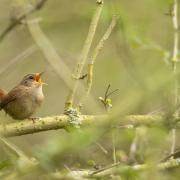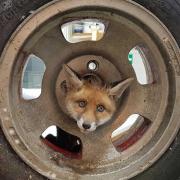Insects in spring
As the weather warms up, we discover what the insects that are emerging from their wintry boltholes are getting up to
Words and photos: Yvonne Couch, of the Essex Field Club
It’s spring, and as the sun comes out and the weather warms up, insects are emerging from their winter hideaways. While some have passed the winter as juveniles and are now concerned with finding enough food to allow them to grow towards adulthood, others overwintered as adults and are more concerned with finding a mate.
Many female insects produce a chemical scent (a pheromone), which is attractive to males, who sense it on the air and follow its trail to the female. The male Emperor Moth can scent a female from well over a mile. Many males may be attracted to a single female, but eventually one male is successful and mating takes place.
In dragonflies and damselflies, the male transfers his sperm to a holding chamber at the front of his abdomen then grips the female by the neck using claspers at the tip of his abdomen; to mate, the female must swing her abdomen forward to connect with the male’s sperm chamber, making what is known as the mating wheel, which is somewhat heart-shaped overall. After mating, the male stays close to the female, sometimes remaining attached while she lays her eggs to ensure he is the father, but in most other insects the female is alone when laying her eggs.
Insect eggs are small, but if you can see them close up, they are incredibly beautiful. The Gorse Shieldbug lays a double row of eggs, which look like little barrels. The Drinker Moth lays eggs resembling boiled sweets – almost good enough to eat. The Orange-tip Butterfly lays ridged conical eggs on hedge garlic; each plant usually holds just one egg, as the caterpillars are cannibals. Orange-tip eggs are easy to spot in spring as they become bright orange soon after being laid.
Insect eggs may be laid in a number of places, including inside plant tissue, in the soil, onto a leaf or twig or into water. In most cases, the eggs are left to develop with no further input, but the female Parent Shieldbug stays next to her eggs until hatched and may even lead the young to food.

Some spiders (which are not insects) wrap their eggs in silk to form a protective egg sac; these sacs may be attached to a leaf or grass stem, while the more mobile Wolf Spiders carry the sac around with them until hatching. The Nursery Web Spider is so-called because, after carrying its egg sac until just before hatching, it then spins a web that serves as a nursery for the newly hatched spiderlings.
Dragonfly eggs, laid into water, hatch into a predatory nymph with an extendible toothed lip, which is shot out to capture prey. This nymph was the inspiration for the jaws of the monster in the film Alien.
Young insects must feed, grow and shed their skin a number of times before becoming an adult; in some cases, they can breed again that year, but many must pass the next winter before the cycle can start again.


































